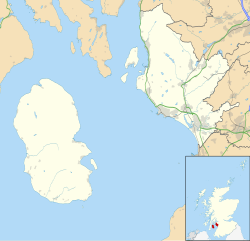Saltcoats
| |
|---|---|
| Town | |
From top, left to right: Saltcoats Prom, and townscape, the North Ayrshire Heritage Centre, Saltcoats Pier, Saltcoats sea front, Saltcoats War Memorial | |
Location within North Ayrshire | |
| Population | 12,250 (2020) [1] |
| • Density | 3,489/sq km |
| OS grid reference | NS245415 |
| • Edinburgh | 77.6 mi (124.9 km) |
| Council area | |
| Lieutenancy area | |
| Country | Scotland |
| Sovereign state | United Kingdom |
| Post town | SALTCOATS |
| Postcode district | KA21 |
| Dialling code | 01294 |
| Police | Scotland |
| Fire | Scottish |
| Ambulance | Scottish |
| UK Parliament | |
| Scottish Parliament | |
Saltcoats (Scottish Gaelic : Baile an t-Salainn; Scots: Saulcuts) is a town on the west coast of North Ayrshire, Scotland. The name is derived from the town's earliest industry when salt was harvested from the sea water of the Firth of Clyde, carried out in small cottages along the shore. It is part of the 'Three Towns' conurbation along with Ardrossan and Stevenston and is the third largest town in North Ayrshire.






